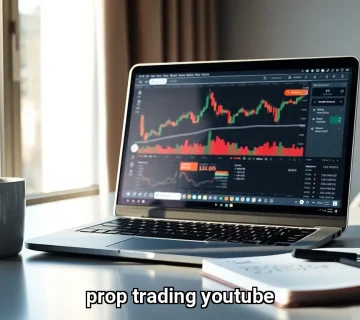Prop Trading Hours play a pivotal role in shaping the strategies and success of traders engaged in proprietary trading. Understanding the optimal trading hours can greatly impact your profitability, especially when navigating dynamic markets like those offered by Propx Pro. These hours define when markets open and close, setting the stage for the strategies traders employ to maximize returns. Whether you are a seasoned professional or new to prop trading, knowing the best times to trade during prop trading hours is essential for optimizing your trading outcomes. Timing is a critical factor, and being aware of the hours that present the best opportunities can lead to substantial success.
In Europe, for example, the day begins with the opening of major indices, creating initial price movements that traders can capitalize on. As the day progresses, different markets open, offering unique opportunities for varying trading strategies. From the active European session to the surge in activity around the U.S. market open, each session holds its importance. Traders need to understand how these market sessions interact, as they can set off ripple effects that influence the market throughout the day. Recognizing these shifts gives traders a competitive edge, crucial for thriving in the fast-paced environment of prop trading.
As you explore the nuances of prop trading hours, you’ll discover how precise timing, market behavior, and adaptive strategies can drive greater profitability. Let’s dive deeper into how mastering prop trading hours can help you achieve your trading goals with Propx Pro, making the most of every opportunity to increase your chances of success.
Prop Trading Hours
Understanding the intricacies of prop trading hours is crucial for anyone involved in proprietary trading. Prop trading hours typically align with the operational hours of the markets being traded, and they can vary significantly depending on geographical location and the specific instruments being traded. For traders in Europe, the day often begins early, with the European markets opening around 7 AM.
This period is characterized by the trading of major indices such as the DAX, Eurostoxx, CAC, and FTSE, allowing traders to capitalize on initial market movements. A strategic approach during these prop trading hours can be pivotal as the volatility tends to be higher, setting the tone for the trading day ahead. Strong price movements during this time can lead to profitable opportunities for those who are well-prepared and alert.
As the morning progresses, from 9 AM to 10:30 AM, traders may focus on the bond markets, especially if any significant news announcements are scheduled. This period can offer valuable trading opportunities, as market reactions to news can create fluctuations that savvy traders can exploit. Staying informed about upcoming announcements and global events is vital during this time. Following this, traders often find that the market tends to quiet down until the afternoon session, providing an opportunity for rest or personal time—an essential aspect of maintaining mental health in a high-stress environment. This downtime is often underappreciated, but it can be crucial for traders to recharge and reassess their strategies before the more hectic trading periods resume.
The afternoon session, particularly from 1:10 PM to 2:30 PM, is typically marked by the opening of the oil pit. This is another critical trading window where news or geopolitical events can lead to increased volatility, allowing traders to engage actively as the market responds to these developments. This is an excellent time for traders to adjust their positions based on the market’s direction. The pace picks up again from 2:30 PM to 4:30 PM with the US market open, which is often regarded as the most significant trading period of the day.
This interval can significantly influence the overall performance and risk appetite for traders, especially for those who need to justify larger trade sizes based on their P&L up to this point. Understanding how to navigate this peak trading time can make a considerable difference in a trader’s daily results.

Understanding Prop Trading Hours
Understanding prop trading hours is not just about knowing when the markets are open; it’s about comprehending how different sessions can impact trading strategies. As traders navigate through these hours, they must be adept at interpreting market signals and adjusting their strategies accordingly. For instance, the lull between 10:30 AM and 1 PM may allow traders to evaluate past trades, analyze market trends, and prepare for the more volatile afternoon sessions. This strategic downtime is crucial, especially for junior traders who may still be learning the ropes of market dynamics and risk management. Utilizing this time effectively can enhance a trader’s understanding of the markets and improve their decision-making skills.
Moreover, the geographic location plays a significant role in structuring a trader’s hours. A trader based in London who covers both European and U.S. markets may find themselves working extended hours to accommodate the varying time zones. This can lead to a grueling schedule of 12 to 14 hours per day, particularly for those in junior roles who are expected to stay after hours to finalize their daily reports. Understanding this dynamic is essential for new traders as it sets realistic expectations for their work-life balance and long-term career sustainability in a competitive environment. Being aware of the demands of the role can help traders develop better coping strategies and maintain a healthier work-life balance.
Importance of Prop Trading Hours
The significance of prop trading hours extends beyond mere time allocation; it encompasses the ability to maximize trading efficiency and profitability. Each trading hour presents unique opportunities that can be leveraged for profit. By being aware of when to trade the most volatile instruments, traders can enhance their P&L. For example, the European open is often accompanied by significant price movements, while the US market open is equally critical as it can lead to rapid price changes based on pre-market sentiment and economic data releases. This awareness can help traders position themselves advantageously and capitalize on fleeting opportunities that others may miss.
Additionally, prop trading firms often employ performance tracking tools that rely on these trading hours to assess trader performance. Accurate tracking enables firms to identify top performers and those needing additional support, fostering a culture of accountability and continuous improvement among traders. This performance analytics process is crucial in a competitive trading environment, as it encourages traders to refine their strategies and adapt to changing market conditions. By focusing on performance metrics during specific trading hours, both traders and firms can enhance their overall effectiveness and profitability.

Maximizing Profits During Prop Trading Hours
To maximize profits during prop trading hours, traders must adopt a proactive and flexible approach. Understanding the unique characteristics of each trading session allows for the optimization of strategies that align with market behavior. For instance, during the high-volume periods of the US market open, implementing strategies that capitalize on quick price movements, such as scalping or momentum trading, can be highly effective. Traders should also remain vigilant during major news releases, as these events can create substantial volatility and trading opportunities. Reacting quickly and decisively during these moments can lead to significant boosts in profitability.
Moreover, effective risk management during these hours is paramount. Traders should establish clear stop-loss and take-profit levels to protect their capital while ensuring they capitalize on profitable trades. Utilizing tools such as real-time reporting and dashboards can provide invaluable insights into individual performance metrics, enabling traders to make informed decisions quickly. By keeping a close eye on their trades and the market conditions, traders can adapt and optimize their strategies in real time, increasing their chances of success.
Propx Pro offers traders advanced analytics and performance tracking tools that can enhance trading strategies during prop trading hours. By leveraging these technologies, traders can identify trends and adjust their positions promptly, leading to improved trading outcomes and profitability. The integration of such tools can streamline the trading process, allowing traders to focus on execution and strategy rather than getting bogged down in data analysis.
Prop Trading Hours Explained
Prop trading hours can be best explained through the lens of a typical trading day. Starting with the European open, traders often begin their day by reviewing global market news and overnight price movements, setting the stage for their trading strategies. The early hours are critical for establishing positions in markets that may experience significant initial volatility. Following the European session, traders can pivot to other markets like the bond market, where early news can influence price action. This flexibility to switch trading focus is vital for capitalizing on opportunities as they arise.
As the day progresses into the US markets, traders must remain agile, adjusting their strategies based on market movements and prevailing news. The closing hours of the trading day often present unique challenges and opportunities, requiring traders to evaluate their performance and prepare for the next trading session. The importance of maintaining focus and managing energy levels cannot be overstated, as prop trading demands both mental acuity and emotional resilience. Developing a routine to manage stress and maintain clarity can significantly enhance a trader’s performance during these critical hours.

Strategies for Trading During Prop Hours
Developing effective strategies for trading during prop hours involves a blend of market knowledge, timing, and psychological readiness. Traders should consider the types of instruments that are most active during specific time frames. For instance, focusing on commodities like oil during the pit open can yield significant returns if the trader is well-versed in the factors influencing that market. Understanding the underlying fundamentals and technical indicators can also help traders make better-informed decisions.
Furthermore, collaboration and communication among traders can enhance overall performance during prop trading hours. Regular discussions about market trends and individual strategies can foster a supportive environment that encourages knowledge sharing and collective growth. Traders should also engage in regular performance reviews and analytics, as these practices can help identify successful strategies and areas for improvement. Building a sense of community within the trading firm can lead to shared insights and strategies that benefit all traders involved.
In summary, prop trading hours are a crucial aspect of a trader’s daily routine. A deep understanding of these hours, combined with effective strategies and tools like those offered by Propx Pro, can empower traders to optimize their performance and achieve their financial goals. Embracing the challenges and opportunities presented by prop trading hours can lead to a rewarding trading experience.
Harnessing the Power of Prop Trading Hours
Mastering prop trading hours is not merely about tracking market openings and closings; it’s about strategically engaging with the dynamic nature of trading sessions to maximize profitability. Each segment of the trading day—from the vibrant European open to the impactful U.S. market launch—offers distinctive opportunities that can significantly affect a trader’s success. By understanding the unique characteristics and volatility associated with different trading hours, traders can tailor their strategies to align with market behavior, thereby enhancing their chances of achieving favorable outcomes. This tailored approach is essential for navigating the complexities of the trading world.
Moreover, a proactive approach, combined with effective risk management and the utilization of advanced trading tools, empowers traders to navigate the complexities of the market with confidence. The insights gained from recognizing the importance of prop trading hours not only aid in optimizing performance but also foster a culture of continuous improvement and collaboration among traders. By sharing strategies and learning from one another, traders can enhance their skills and adapt more quickly to changing market conditions.
Ultimately, by embracing the intricacies of prop trading hours, traders can position themselves to seize opportunities, refine their tactics, and thrive in the competitive landscape of proprietary trading. The mastery of prop trading hours is not just a skill; it is a vital component of a trader’s success, enabling them to navigate the markets successfully and achieve their financial aspirations.




No comment